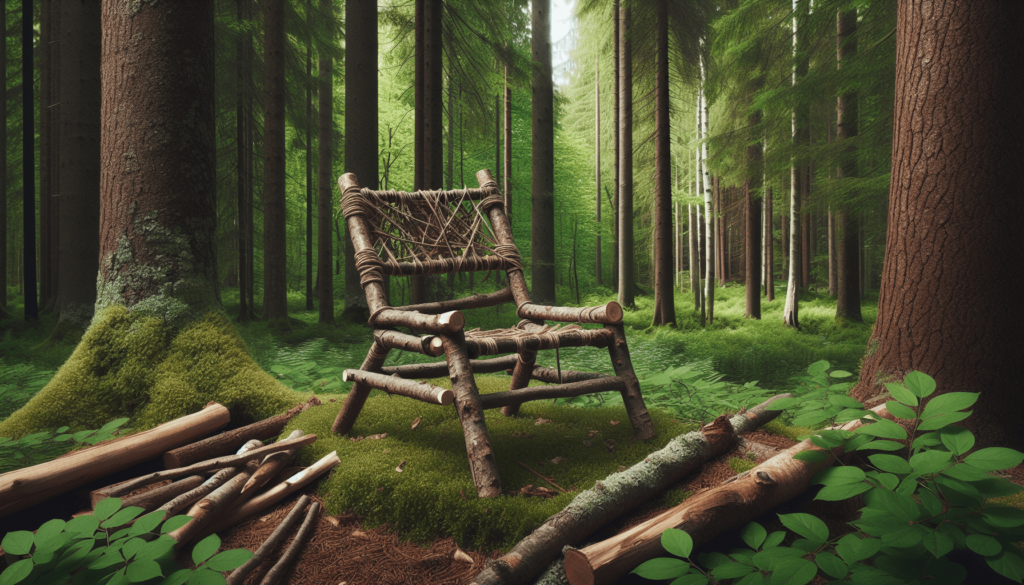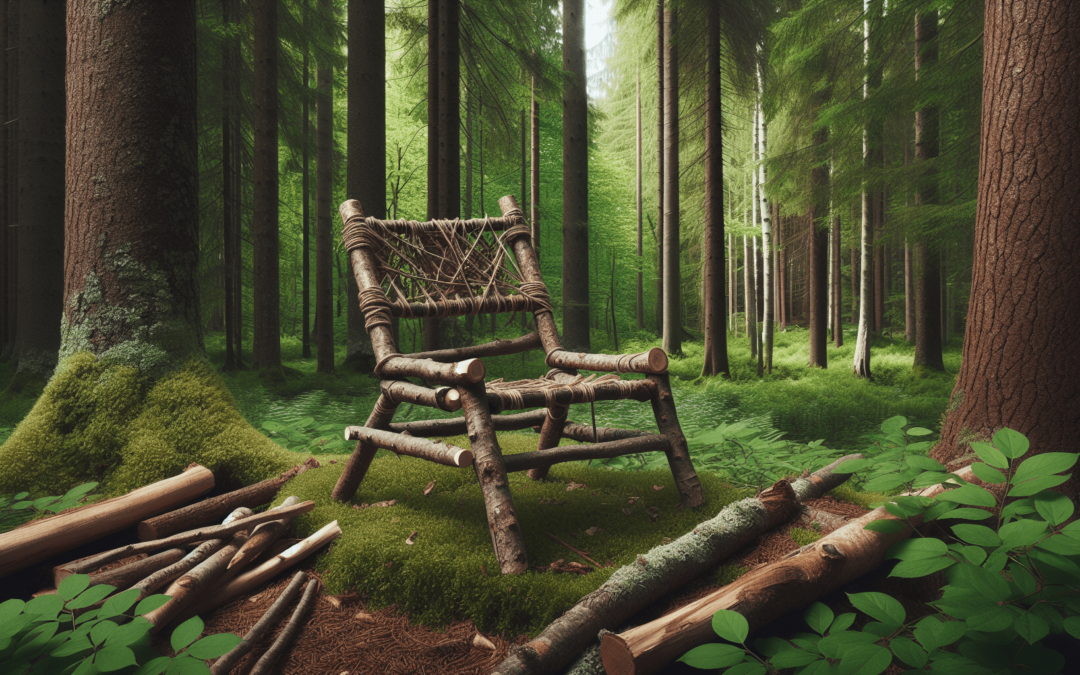Building A Bushcraft Chair For Camp Comfort
When you’re out in the wild, nothing beats the satisfaction of crafting something useful with your own hands. In “Building A Bushcraft Chair for Camp Comfort,” you’ll discover how to create a sturdy, comfortable chair using natural materials found in the forest. This guide will take you step-by-step through the process, ensuring that your outdoor adventures are not only thrilling but also comfortable. Get ready to relax by the campfire in a chair you built yourself! Have you ever been out in the wilderness and found yourself longing for a comfortable place to sit and relax? Building a bushcraft chair for camp comfort can be a game-changer for your outdoor experience. It’s not just about luxury; it’s about finding a bit of respite after a long day of exploring or a grueling hike.

What is Bushcraft?
Bushcraft is more than just a fancy term for survival skills; it’s an ancient practice of utilizing the natural resources around you to live and thrive in the wild. Whether you’re fashioning tools, building shelters, or making furniture like a bushcraft chair, these skills can greatly enhance your camping experience.
Why Build a Bushcraft Chair?
Comfort is paramount when you’re out in the wilderness for extended periods. While sitting on logs or cold, hard ground can suffice, having a chair elevates your experience. A well-constructed bushcraft chair provides:
- Superior Comfort: A sturdy seat to support your back and legs.
- Enhanced Morale: A touch of home comfort boosts your spirits.
- Versatility: Can be used for various activities like cooking, reading, or relaxing.
Essential Tools and Materials
To build a bushcraft chair, you’ll need certain tools and materials. Don’t worry if you’re new to this, as many of the items can often be found or constructed using the natural environment around you.
Tools You’ll Need
Here’s a handy table that gives you a quick look at the essential tools required:
| Tool | Description |
|---|---|
| Knife | For cutting smaller branches or details |
| Folding Saw | To cut through larger branches or wood sections |
| Paracord/Rope | For lashings and bindings |
| Hatchet/Axe | Handy for chopping wood sections |
| Measuring Tape | To ensure your chair parts fit together well |
Materials Required
The materials you mostly need are wood and biodegradable cordage. Here’s a basic rundown:
- Wooden Poles: For the chair frame.
- Cross Sections: Smaller, sturdy branches for support.
- Cordage: Natural fiber or paracord to tie the structure together.
Selecting the Ideal Site
Every craftsman needs a good workshop, and your choice of site can make the process of building a bushcraft chair easier or more challenging. Look for a flat, stable area with ample resources.
Tips for Site Selection
- Proximity to Resources: Choose a spot near wood and other natural materials.
- Flat Ground: Easier to stabilize the chair.
- Protection from Elements: Consider wind direction and natural cover.
Gathering Materials: Wood Selection
Selecting the right wood is crucial. You’ll need different types of wood for different parts of the chair —mainly for durability and ease of use.
Types of Wood to Use
Here’s a quick guide to help you choose the right type:
| Part of Chair | Type of Wood | Characteristics |
|---|---|---|
| Frame | Hardwood (oak, maple) | Strong and durable |
| Cross Sections | Softwood (pine, fir) | Easier to work with, still durable |
| Lashings | Flexible (willow, hazel) | Easy to bend and twist |
Cutting and Preparing Wood
- Measure and Cut: Use your measuring tape to cut wood to required lengths.
- Debark and Smooth: It’s best to remove bark and smooth edges to prevent injuries.
- Seasoning: If possible, allow the wood to dry for a few days to strengthen it.

Construction Steps
Step 1: Building the Frame
The frame is the backbone of your bushcraft chair. In this step, you’ll create a sturdy base that will support the entire structure.
Crafting the Legs and Back Supports
- Legs: Cut four sturdy poles, generally about waist-high.
- Back Supports: Two poles, similar length to legs or slightly longer.
- Frame Assembly: Lay out legs and back supports in a quadrilateral shape and bind the joints tightly with paracord.
Step 2: Making the Seat
The seat is the part where comfort really comes into play. This step involves adding cross sections and perhaps even a woven seat for added comfort.
Adding Cross Sections
- Cut Shorter Poles: Make around 4-6 short cross sections.
- Attach Securely: Lash these securely to the main frame.
Step 3: Creating the Backrest
A good backrest provides comfort and support, especially after a long day.
Lashing the Backrest Poles
- Cut and Prepare: A couple of horizontal poles.
- Attach to Back Supports: Lash them firmly to the upright back supports.
Detailed Instructions: Lashing Techniques
Good lashing techniques can make or break your bushcraft chair. It’s crucial to know a few sturdy lashing knots.
Common Lashing Knots
| Knot Type | Use |
|---|---|
| Square Lashing | To secure poles at right angles |
| Diagonal Lashing | To brace angles |
| Shear Lashing | To tie two poles side by side |
Step-by-Step Lashing Guide
- Square Lashing: Start with a clove hitch, wrap the rope around both poles at right angles, finish with another clove hitch.
- Diagonal Lashing: Begin with a timber hitch, alternate wraps over and under both poles, finish with a clove hitch.
- Shear Lashing: Start with a clove hitch on one pole, wrap around both poles multiple times, finish with a frapping wrap to tighten.
Adding Comfort Elements
While the basic structure is functional, adding a few elements can significantly enhance comfort.
Improving Seat Area
- Woven Seat: Weave flexible twigs or use a swath of fabric or paracord to create a more cushioned seat.
- Padding: Moss or leaves can serve as natural padding.
Enhancing Backrest
- Cushioning: A makeshift cushion from natural materials.
- Angle Adjustment: Tie the top of the backrest at a slight angle for more comfort.
Maintenance and Safety Tips
Any structure made from natural materials needs some care, especially when exposed to outdoor elements over time.
Regular Maintenance
- Check Lashings: Regularly inspect and tighten where necessary.
- Inspect Wood: Make sure no parts are weakening or rotting.
Safety Precautions
- Weight Capacity: Don’t overload the chair beyond what the materials can handle.
- Environment: Ensure the area where your chair is placed is free of hazards like sharp objects or unstable ground.
Versatile Uses
One of the excellent aspects of a bushcraft chair is its versatility. Depending on its structure, it can serve multiple purposes.
Multiple Configurations
- Single Chair: Standard model for one person.
- Bench Style: Wider seat for two individuals.
- Recliner: Adjustable backrest for a more relaxed seating position.
Eco-Friendly Practices
Building a bushcraft chair is an eco-friendly activity when done correctly. It minimizes impact on the environment by using biodegradable materials and simple hand tools.
Sustainable Wood Harvesting
- Dead or Fallen Wood: Prefer using wood that’s already fallen.
- Harvest in Moderation: Don’t overharvest from a single area.
Conclusion: Your Own Bushcraft Chair
Building a bushcraft chair is a deeply rewarding experience that enhances your time spent in the great outdoors. Not only does it provide the much-needed comfort, but it also hones your skills in utilizing and appreciating natural resources. So the next time you head out into the wilderness, why not take some time to build your own bushcraft chair? You’ll not only enjoy a comfortable seat but also leave with a sense of accomplishment and enhanced bushcraft skills.
Embark on this journey of creating your own camp comfort, and you’ll likely find it’s an experience worth its weight in gold — or at least in outdoor relaxation! Happy camping!

